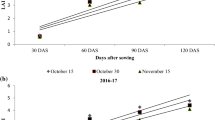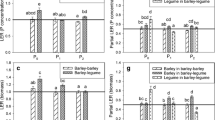Abstract
Effects of black locust (Robinia pseudoacacia L.) on productivity and N nutrition of barley (Hordeum vulgare L.) were evaluated under various management regimes (2 soil types, 3 levels of N fertilizer, and 3 cropping systems — barley alone, and barley intercropped with trees pruned or unpruned).
Intercropping did not affect productivity and N nutrition of barley in 1988 when trees were small. However, there was a significant yield decline in 1989 as the trees grew bigger. On average, productivity of the sole crop was 8% higher in both soil types. Pruning and mulching moderated the yield reduction compared with the unpruned treatment. Competition for soil moisture was considered a major constraint. Nonetheless, the overall productivity (barley+black locust) from the intercropped treatments was 53% higher than sole cropping.
In 1989 and 1990, intercropped barley had significantly higher grain and straw N concentrations (%). In 1989, for example, grain N content was 11% higher than in the sole crop. Removal of trees in 1990 resulted in significant increase in productivity and N content of subsequent barley crop relative to continuous sole cropping. From N nutrition viewpoint, barley from previously intercropped treatments showed superior quality and it had, on average, 23% higher grain N content than the sole crop. This was attributed to N2-fixation and N return by black locust. It was estimated that black locust contributed about 36 kg N ha−1 to the system.
This study underscores the role black locust is potentially capable of playing in the development of sustainable and low-input agricultural systems in temperate regions. Nonetheless, the study also illustrates the importance of the below and above-ground interactions that occur in intercropped systems and the need for further research in this area.
Similar content being viewed by others
References
Boring WT, Swank JB and Henderson GS (1988) Sources, fates, and impacts of nitrogen inputs to terrestrial ecosystems: review and synthesis. Biogeochem 6: 119–159
Daniel JN, Ong CK and Kumar MS (1991) Growth and resource utilization of perenial pigeonpea (Cajanus cajan L.) at the tree-crop interface. Agroforestry Systems 16: 177–192
Dawson JO and Paschke MW (1991) Current and potential uses of N2-fixing trees and shrubs in temperate agroforestry systems. In: Garrett HE (ed) The 2nd Conference on Agroforestry in North America, pp 183–209. August 18–21, 1991, Springfield, MO. University of Missouri Columbia, MO
Huntley JC (1990) Black locust. In: Burns RM and Honkala BH (tech. coords) Silvics of North America. Vol. 2: Hardwoods, pp 755–761. Agriculture Handbook 654. US Dept Agric For Serv Washington, DC
Ingram J (1990) The role of trees in maintaining and improving soil productivity: a review of the literature. In: Prinsley RT (ed) Agroforestry for Sustainable Production: Economic Implications, pp 243–303. Commonwealth Science Council, London
Izaurralde RC, Juma NG and McGill WB (1990) Plant and N yield of barley-field pea intercrop in cryoboreal-subhumid Central Alberta. Agron J 82: 295–301
Kang BT (1988) Nitrogen cycling in multiple cropping systems. In: Wilson JR (ed) Advances in Nitrogen Cycling in Agricultural Ecosystems, pp 333–348. CAB International, Oxford, UK
Kang BT, Reynolds L and Atta-Krah AN (1990) Alley farming. Adv Agron 43: 315–359
Kang BT and Wilson GF (1987) The development of alley cropping as a promising agroforestry technology. In: Steppler HA and Nair PKR (eds) Agroforestry: A Decade of Development, pp 227–244. ICRAF, Nairobi, Kenya
Keresztesi B (1988a) The Black Locust. Akademiai Kiado, Budapest
Keresztesi B (1988b) Black locust: the tree of agriculture. Outlook Agric 17: 77–85
Lawson TL and Kang BT (1990) Yield of maize and cowpea in an alley cropping system in relation to available light. Agric For Meteorol 52: 347–357
Liyanage MS, Jayasundara PS and Perera KCP (1990) Effect of leaf mulches from several N2-fixing tree species on soil microclimate. In: Gunasena HPM (ed) Proc Regional Workshop on Multipurpose Tree Species, pp 18–26. 22–24 March, 1990, Kandy, Sri Lanka. Winrock International, F/FRED, Bangkok
Mebrahtu T and Hanover JW (1989) Effects of nitrogen level on gas exchange, growth, and leaf traits of black locust. Dept Forestry, Michigan State University, East Lansing, MI
Mittal SP and Singh P (1989) Intercropping field crops between rows of leucaena under rainfed conditions in northern India. Agroforestry Systems 8: 165–172
Nair PKR (1984) Soil Productivity Aspects of Agroforestry. ICRAF, Nairobi, Kenya
Neumann F and Pietrowicz P (1989) Light and water availability in fields with and without trees: an example from Nyabisindu in Rwanda. In: Reifsnyder WS and Darnhofer TO (eds) Meteorology and Agroforestry, pp 401–406. ICRAF, Nairobi, Kenya
Ntayombya P (1993) Effects of black locust on productivity and nitrogen nutrition of intercropped barley: agroforestry's role in sustainable land-use systems. PhD Thesis, University of Guelph, Guelph, Ontario, Canada
Ontario Ministry of Agriculture and Food (OMAF) (1992) Field Crop Recommendations. Publication No 296. Queen's Printer for Ontario, OMAF, Guelph, Ontario
Pettersson R (1989) Above-ground growth dynamics and net production of spring barley in relation to nitrogen fertilization. Swedish J Agric Res 19: 135–145
Prinsley RT and Swift MJ (1987) Amelioration of Soil by Trees: A Review of Current Concepts and Practices. Commonwealth Science Council, London
Sanchez PA (1987) Soil productivity and sustainability in agroforestry systems. In: Steppler HA and Nair PKR (eds) Agroforestry: A Decade of Development, pp 205–226. ICRAF, Nairobi, Kenya
SAS Institute Inc. (1988) SAS/STAT User's Guide, Release 6.03 Edition. Cary, NC
Singh RP, Ong CK and Saharan N (1989) Above and below ground interactions in alley-cropping in semi-arid India. Agroforestry Systems 9: 259–274
Ssekabembe CK and Henderlong PR (1991) Below-ground interactions in alley cropping; appraisal of first-year observations on maize grown in black locust (Robinia pseudoacacia L.) alleys. In: Garrett HE (ed) The 2nd Conference on Agroforestry in North America, pp 183–209. August 18–21, 1991, Springfield, MO. University of Missouri, Columbia, MO
Stringer JW and Carpenter SB (1986) Energy yield of black locust biomass fuel. For Sci 32: 1049–1057
Tel DA and Rao PV (1982) Automated and Semi-Automated Methods for Soil and Plant Analysis. Manual Series No 7. IITA, Ibadan, Nigeria
Tripathi SB and Hazra CR (1986) Forage yield of oats and barley as influenced by nitrogen fertilization under agroforestry production system. J Indian Soc Soil Sci 34: 774–779
Vergara NT (1987) Agroforestry: a sustainable land use for fragile ecosystems in the humid tropics. In: Gholz HL (ed) Agroforestry: Realities, Possibilities and Potentials, pp 7–30. Martinus Nijhoff Publishers, Dordrecht, The Netherlands
Wilson GF, Kang BT and Mulongoy K (1986) Alley cropping: trees as source of green-manure and mulch in the tropics. Biol Agric Hort 3:251–267
Young A (1989) Agroforestry for Soil Conservation, CAB International, Oxford, UK
Zar JH (1984) Biostatistical Analysis, 2nd edition. Prentice-Hall Inc, Englewood Cliffs, NJ
Author information
Authors and Affiliations
Rights and permissions
About this article
Cite this article
Ntayombya, P., Gordon, A.M. Effects of black locust on productivity and nitrogen nutrition of intercropped barley. Agroforest Syst 29, 239–254 (1995). https://doi.org/10.1007/BF00704871
Issue Date:
DOI: https://doi.org/10.1007/BF00704871




